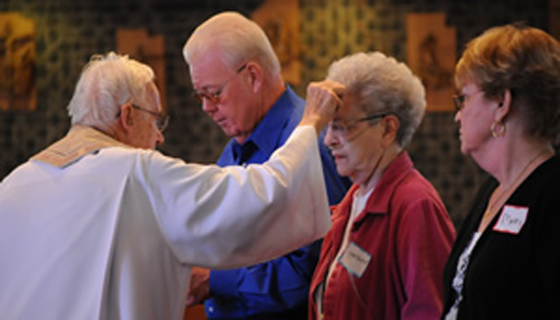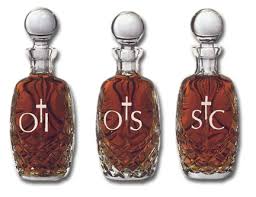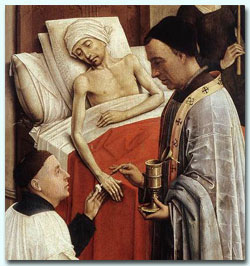The Sacraments – Anointing of the Sick

From the early middle ages until after the Second Vatican Council this sacrament was known as extreme unction (final anointing). It was administered only when death was near and bodily recovery of the sick person was not ordinarily looked for. The emphasis was on preparing the sick person for entry into the next life – forgiveness of sins and Holy Communion were an important part of the rite.
 The anointing was done with holy oil, usually on the forehead and hands. The picture shows three jars of holy oil: the Oil of the Infirm (“Oleum Infirmorum”) for the anointing of the sick; the Oil of Catechumens (“Oleum Catechumenorum” or “Oleum Sanctorum”) for baptism; and holy chrism (“Sacrum Chrisma”) for baptism, confirmation, and holy orders.
The anointing was done with holy oil, usually on the forehead and hands. The picture shows three jars of holy oil: the Oil of the Infirm (“Oleum Infirmorum”) for the anointing of the sick; the Oil of Catechumens (“Oleum Catechumenorum” or “Oleum Sanctorum”) for baptism; and holy chrism (“Sacrum Chrisma”) for baptism, confirmation, and holy orders.
Since 1972, when the name anointing of the sick was adopted, the emphasis has been on the sick person rather than the dying person. The basis for the sacrament lies, principally, in the letter of James, the Brother of the Lord, but also in the gospel of Mark:
“Is any among you sick? Let him call for the elders of the church, and let them pray over him, anointing him with oil in the name of the Lord; and the prayer of faith will save the sick man, and the Lord will raise him up; and if he has committed sins, he will be forgiven.”
[ James 5:14-15 ].
“So they [ the twelve apostles ] went out and proclaimed that people should repent. And they cast out many demons, and anointed with oil many that were sick and healed them”.
[ Mark 6:12-13 ].

The picture shows a detail from the Seven Sacraments painting. In the foreground a man is being ordained (see The Sacrament of Holy Orders). In the background a sick man lies in bed. He’s not in great shape and a good feed would do him no harm. Can you find this detail in the full picture?
